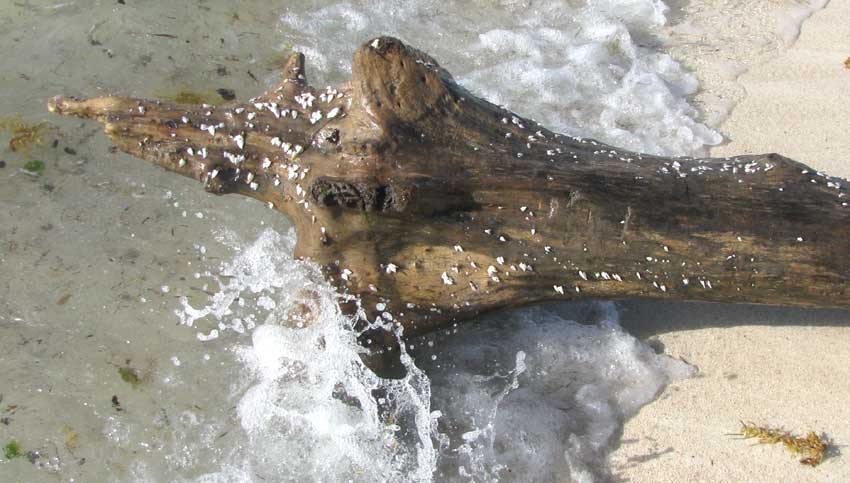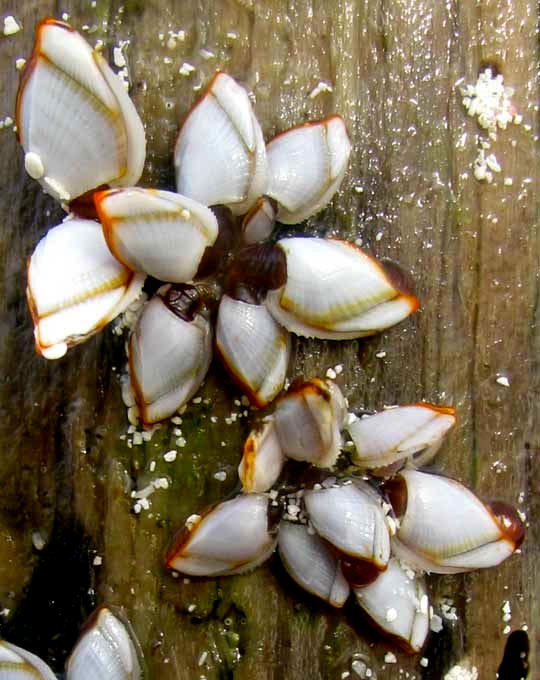Excerpts from Jim Conrad's
Naturalist Newsletter

from the August 7, 2011 Newsletter issued from Mayan Beach Garden Inn 20 kms north of Mahahual; Caribbean coastal beach and mangroves, ~N18.89°, ~W87.64°, Quintana Roo state, MÉXICO
GOOSE BARNACLES ON A WASHED-UP TREE
Goose Barnacles -- which are crustacean arthropods -- are very commonly seen on the beach here, attached to things that have been floating long distances. For instance, the other day a medium-sized tree trunk washed up on the beach covered with them, as shown above. A close-up showing them clustering on we wood is shown below:

In that picture notice the dark brown, fleshy "stalks," or peduncles, extending from each shell and attaching to the wood. These peduncles are characteristic of the "stalked barnacles." In contrast, the shells of "acorn barnacles" attach directly the substrate and lack peduncles.
While Googling info about the peduncles I came upon this little fact: In terms of relative body size, barnacles possess the largest penises of the entire animal kingdom. They extend as much as eight times the barnacle's length. This makes sense if you're a male interested in procreation but you're stuck to one spot.
Several stalked barnacle species are called goose barnacles, but so far the only one I've seen here, the one in the pictures, is LEPAS ANSERIFERA. Another similar goose barnacle species is said to occur here, Lepas anatifera. In the pictures you can see how Lepas anserifera's shells are deeply, broadly and shallowly grooved. Lepas anatifera's shells are etched with much finer striations.
from the December 15, 2008 Newsletter issued from Mayan Beach Garden Inn 20 kms north of Mahahual; Caribbean coastal beach and mangroves, ~N18.89°, ~W87.64°, Quintana Roo state, MÉXICO
GOOSE BARNACLE ON AN OIL CAN
The other morning on the beach I picked up a black, plastic container previously containing a quart of oil, and attached to it was the item shown below:

In the picture the shell's left side is attached to the can. If you flip the picture 90° counterclockwise the shell looks like a white butterfly with an orange rim along its upper wing. I felt sure that its name would be something like "Butterfly Barnacle" but when I showed it to a visitor she exclaimed "Oh, you've found a Goose Barnacle."
In an instant I saw what was goosy about it. As it's shown in the picture, doesn't it look like a goose's head, the broad, bulging area at the lower left being the cheek?
After the barnacle had been out of the water awhile, the slit between the orange rims opened a bit and a dark, spidery thing appeared. Those feathery items were the crustacean's modified legs, which in water beat rhythmically to draw plankton and detritus into the shell for consumption.
The barnacle lifecycle is complex, involving two larval stages. You can read about it and see pictures at https://en.wikipedia.org/wiki/Barnacle.
Goose Barnacles are LEPAS ANSERIFERA and they enjoy a worldwide distribution. They're crustaceans.